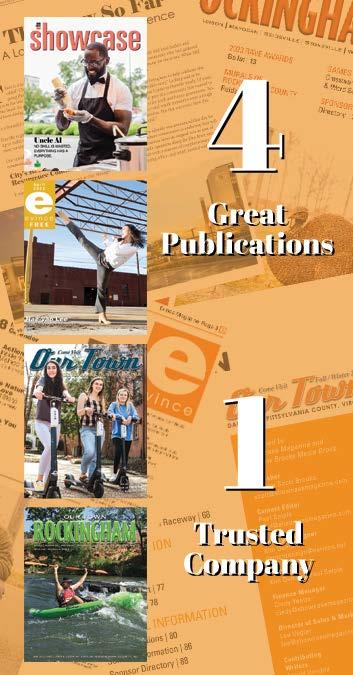




















JULY 2023
CEO Andrew Scott Brooks scott@showcasemagazine.com
EDITORIAL DIRECTOR
Paul Seiple | paul@showcasemagazine.com
GRAPHIC DESIGNER Kim Demont | demontdesign@verizon.net
FINANCE MANAGER Cindy Astin | cindy@showcasemagazine.com
ADVERTISING
Lee Vogler | Director of Sales and Marketing lee@showcasemagazine.com | 434.548.5335

Emily Wilkerson | Executive Assistant emily@showcasemagazine.com
753 Main Street #3, Danville, VA 24541 Phone 434.709.7349 info@showcasemagazine.com www.showcasemagazine.com
CONTRIBUTING WRITERS
Paulette Dean | Harvey Minnick
Paul Seiple | Lee Vogler
CONTRIBUTING
PHOTOGRAPHERS
Harvey Minnick | Laura Mae Photography Lee Vogler
COVER Britt Hart photo by Laura Mae Photography
Scan with your smart phone for EXCLUSIVE ONLINE CONTENT at showcasemagazine.com






Brit Hart is “the girl who would fight a dragon if you asked her to.” She developed a love for sports early in life. “I started playing soccer, competitively, at age five.” The passion seeped into Hart’s education, helping her to earn a master’s degree in sports management.
Even though her career path was trending up, not all was a positive in Hart’s life. She added, “I was in a physically abusive marriage and after being taken by ambulance to the hospital, I found myself in a downfall from several serious consequences of domestic violence.”
Hart began looking for an escape from reality. She found it at a boxing gym. “I wanted to forget the nightmare I was living for just one moment—and it worked. More importantly, I was good at it,” Hart added.
Preparing for fights is something Hart doesn’t take lightly. “I make sure in camp I train 3 times a day. Cardio, weights, and something fun or skillful,” she said. But she also knows that keeping the passion for what you do is essential both physically and mentally. She
Continued to Page 13






finds one song that becomes her theme for whatever she’s going through, listening to it on repeat, and living in that emotion. “It’s always really had the power to motivate and move me to know that I am fighting for something greater than myself.”
Pressure is something that comes along with any sport. Hart continued, “I was thrown to the wolves early in my career. I main evented my third pro boxing fight, and I was the main event for my first bare knuckle fight. So, I’m used to it.” Even with that experience, pressure still exists, but Hart tells herself, “I asked to be here. This is what I do.”
Fighters face many obstacles when they step into the ring. Hart says her biggest challenge is within. It’s heart. “But it’s probably my biggest strength, too. I care a lot about people and relationships, but also what they say or think.” Learning not to let that affect her is a process all its own.
Hart describes herself as “one of a kind and different from other fighters.” She elaborated, “I do the things fighters should do, not what sounds or looks good. I’ve put myself in scary, uncharted waters. I fight with my back on ropes constantly, but always find a way to win.” She attributed her diversified skills as a key to her success in the ring.
Balancing training and competing with other aspects of her life, such as work or family, is difficult. “But I have my education to thank. I tell everyone, school is so important even if you don’t use your degree because it teaches you to juggle lots of things and meet deadlines.” Hart approaches training as if it were classes. “Instead of 3 classes a day. Typically, 1-2 hours, it’s training. It gets done, and then I move on to family, work, and friends. I’m a huge ‘write it down in a planner’ person. Just as I was in school. So, I stay on point.”
Hart isn’t slowing down soon. “My goals are to be a 4-time champ in the 115-weight class (strawweight) and then climb to 125 to make a claim at the belt. After that, I have nothing else to prove to anyone and want to change my focus into motivational speaking and teaching clinics.” She aspires to help shape the futures of others.

To Hart, Danville, Virginia is her fighting home. “I remember having no place to really call home at one time. Everywhere I went; it didn’t matter how hard I tried; people had already formulated an opinion about me—until I came to Danville.” She always felt like she belonged and was loved there. Hart also found a lifelong friend in coach Marcus Luck who trained her when no one else would. “Coach Marcus also showed me the deeper meaning of why we box. He might not admit it, but seeing the goodness in everything was the true gift he shared with me.”
Hart has always been content by just being herself. “With that power, I changed history by believing in a fairy tale and turning it into reality. From my home being on the streets to now, the world is my backyard.”
Continued from Page 10


When people learn I was a pilot and used to own and fly a reproduction fighter from World War One, they usually ask what was it like to fly it?

The first thing you notice is how small it is. Getting in a Cessna or any other general aviation light aircraft is like getting into one of those little British sports cars. A little cramped but comfortable. Climbing into my SPAD was like putting on a snowsuit. You were basically wearing the plane. I guess it is like that with all fighter planes, new or old. I can’t say it was uncomfortable. Every time I got in, I was so full of adrenalin and could have sat on a bed of nails and not noticed.
Being an open cockpit plane, a helmet and goggles were called for, and there was a three-point harness. The long silk scarf was optional. But at least I didn’t have
two machine guns in my face. The divots were there for them, but my plane was unarmed, which made it lighter and more maneuverable. It flew like a dream and could climb faster than a modern Cessna., which is not bad for a 100+-year-old design.
There were a few modern concessions for safety. The wings weren’t covered with linen but with a modern, mylar-like plastic film. I had a handheld radio and ear bud that sometimes worked. I also had an electric starter motor installed with the battery tucked in the back of the seat. Starting an airplane motor by spinning the prop is a lost and dangerous art. I heard that one of my flight instructors in Iowa was killed by accidentally pulling on a pro that turned over and struck him in the head.
The other modern concession was bicycle breaks. SPADs in WWI didn’t have them. Normally, the breaks are on the rudder pedals, but to keep things simple, they were rigged to the gun trigger on the joystick. Oh, that’s right. No steering wheel or yoke, just a joystick. It was very easy to get accustomed to.
Once strapped in, I would make a call on the radio and go through the short checklist. When the engine came to life, the noise drowned everything out. You would throttle back to allow things to warm up before heading out. A SPAD has louvers that can be opened or closed to control engine heating.
My SPAD, like virtually every other airplane from before 1945, was a taildragger. In that, it had two big wheels in front and a small wheel (or skid) in back under the tail. Virtually all modern aircraft have tricycle landing gear with one wheel under the nose and two wheels in back under the wings.
Taildraggers handle differently on the ground and during
taking off and landing, and you must be specially trained to fly them. I got my training in Hagerstown, Maryland.
The biggest and most alarming difference is while taking off. The tail on a taildragger comes up off the ground as you are rolling down the runway. Once you have left the ground, most of the vibrations stop, and there is only the sound of the engine and the sun and wind on your face.
You could navigate using a Garmin GPS or just drop down and read the road signs. I could look down at the cars and trucks whizzing along on the interstate and some of them were going faster than me, but I was going in style and could cut miles off the distance by rounding off the corners.
I had a magnetic campus and an altimeter. There was an artificial horizon and bank indicator that was nothing more than a carpenter’s level. A few other gages to monitor the engine temperate and oil pressure.
The airspeed indicator was a small L-shaped glass tube that was tied to a wing strut outside of the prop wash. The wind would blow into it and push a pea up or down, depending on wind speed.
There was a window in the fuel line to see fuel flow and a cork floating in the fuel tank with a rod sticking out of it. You could see the tip of the rod go up and down with the fuel level. Always problematic in flight. A clock was also used to keep track of them and how long the engine had been running. After 90 minutes, it was time to look for a place to land as you only had another 30 minutes of reserve fuel, assuming you took off with a full-fuel load.
The landing gear was fixed down and consisted of two bicycle wheels and a small trolly wheel in the rear, no skid, as would be historically correct. Bungee cords were wrapped around the exiles to act as shock absorbers.
Being a single-seat open cockpit airplane, it is just you, the buzz of the engine, and the sun. People talk of the wind in the wires (the bracing wires that crisscrossed between the wings and struts), but I never heard them. The propeller was invisible in flight unless the sun was at your back. Then you could see the sheen dancing along the propeller blades.
Once, I nearly hit a turkey vulture while coming in on approach. That was one big bird. That was the only time I wasn’t alone with Vicky in the air.
I never flew her in bad weather or high enough to need oxygen. I say her because my SPAD’s name was Vicky short for Victoria. I had the likeness of a blonde angel in a mini toga brandishing the swift sword of God painted on her side. Vicky’s likeness was surrounded by this inscription, “CARUS DOMINUS ANGELUS MITTERE
VIGILUS MEUS”. Meaning, “Dear Lord, please send one of your angels to watch over me.” Or that’s what it was supposed to say. My SPAD was the prettiest thing in the air, with her red and white stripes and blue nose and tail with stars like an American flag and US roundels on the wings.
After the victory in WWI, the American Army Air Service went on a victory tour and had their planes painted to celebrate. My plane was a copy of the SPAD XIII flown by Captain Reed Chambers of the 94th Aero Squadron, the Hat in. Ring Squadron.
Owning and flying Vicky was utterly joyful, but totally impractical and was probably a mid-life crisis kind of thing. Every time I landed, which was always an occasion to celebrate, Vicky would be the center of attention. In 2000, I moved from Iowa and continued flying Vicky until I had a landing mishap in 2003. No one would work on her and there was a limit to what I could do, so I had to sell her. I later heard that her new owner tore her up on the ground. Such a sad ending for a beautiful flying machine.








When you read that, you likely heard Alice Cooper’s voice from his singsong-y classic. (You’re welcome for getting it stuck in your head all day). There is a key line in that song, that as a parent sticks with me in a way it didn’t when I was younger— “I’m bored to pieces.”
As much as school-age children talk about looking forward to summer break (and the vast majority of them genuinely do), once it comes many do become “bored to pieces.” After being in a structured environment five days a week for nine months of the year, suddenly they’re at home with hours of free time.
The first week is likely a blast. Video games, YouTube marathons, sleeping in…you name it. But then what? We try to keep our kids active in


the Vogler household. As frequent readers already know, Kingston (my son) and Ava (my daughter) are involved in multiple sports, dance classes, and other activities. Some



of that does carry over into summer break.
We also try to get them involved in different camps during the break, like the Camp Invention Kingston is doing or the Kindermusik classes Ava does. There are other things we can do to keep our kids active. Something as simple as walks along the Riverwalk trail, where they try to point out how many different animals they can find during the walk, can keep them engaged during the summer break. The Danville Public Library also has a really cool summer reading challenge.
My point is: summer break is fun. It should be a time for relaxation and a recharging of the batteries. But let’s stay active and not be “bored to pieces.”


Perhaps it’s because I was raised as an Army brat (father, 21 years in the US Army; mother, three years in the WAC), I have always been interested in reading biographies of people who helped found this country. Through the years, I have expanded that interest into reading personal accounts of soldiers who served in wars throughout our history. That means I remember a lot of stories, but do not remember the source! However, since Wikipedia also includes the story to a terrier belonging to a British commander during the Revolutionary War, I feel confident sharing it.
Many of the commanders took their dogs with them near the battlefields. They enjoyed the company, but also used them as hunting dogs. General Sir William Howe, a British commander, kept dogs with him, including a fox terrier named Lila.
On October 4, 1777, there was a surprise attack on the British at Germantown. The battlefield must be a terrifying place and Lila was lost. She wound up with the American Army in its encampment. General Howe’s dog came to the attention of General George Washington. Lila’s dog collar had Howe’s name engraved on it.
General Washington ordered his soldiers to return Lila to General Howe, the enemy, and history records. He included a polite note.
I love this story because it tells of human kindness during a bloody war. It also is a testimony to the importance of making sure your pets have identification on them!
Every shelter employee would absolutely love it if every animal came in with an owner’s contact information on them. Good job, General Howe!



